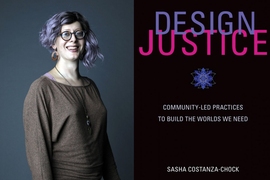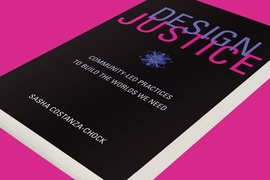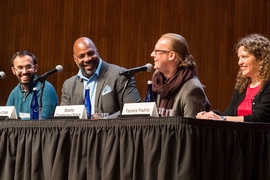When Sasha Costanza-Chock goes through airport security, it is an unusually uncomfortable experience.
Costanza-Chock, an MIT associate professor, is transgender and nonbinary. They use the pronouns they/them, and their body does not match binary norms. But airport security millimeter wave scanners are set up with binary, male/female configurations. To operate the machine, agents press a button based on their assumptions about the person entering the scanner: blue for “boy,” or pink for “girl.” The machine nearly always flags Costanza-Chock for a hands-on check by security officials.
“I know I’m almost certainly about to experience an embarrassing, uncomfortable, and perhaps humiliating search … after my body is flagged as anomalous by the millimeter wave scanner,” they write, recounting one such episode, in a new book about technology, design, and social justice.
This is an experience familiar to many who fall outside the system’s norms, Costanza-Chock explains: Trans and gender nonconforming people’s bodies, black women’s hair, head wraps, and assistive devices are regularly flagged as “risky.”
The airport security scanner is just one type of problem that emerges when technology does not match social reality. There are biases built into everyday objects, including software interfaces, medical devices, social media, and the built environment, and these biases reflect existing power structures in society.
The new book — “Design Justice: Community Led Practices to Build the Worlds We Need,” published by the MIT Press — looks broadly at such shortcomings and offers a framework for fixing them while lifting up methods of technology design that can be used to help build a more inclusive future.
“Design justice is both a community of practice, and a framework for analysis,” says Costanza-Chock, who is the Mitsui Career Development Associate Professor in MIT’s Comparative Media Studies/Writing program. “In the book I’m trying to both narrate the emergence of this community, based on my own participation in it, and rethink some of the core concepts from design theory through this lens.”
Who designs?
The book has its roots in the activities of the Design Justice Network (DJN), founded in 2016 with the aim of “rethinking design processes so they center people who are often marginalized by design,” in the organization’s own description. (Costanza-Chock sits on the DJN’s steering committee.) The book draws on the concepts of intersectional feminism and the idea that technologies, and society more broadly, are structured by what the black feminist sociologist Patricia Hill Collins calls a “matrix of domination” in the form of white supremacy, heteropatriarchy, capitalism, and settler colonialism.
The book also looks at the issue of who designs technology, a subject Costanza-Chock has examined extensively — for instance in the 2018 report “#MoreThanCode,” which pointed out the need for more systematic inclusion and equity efforts in the emerging field of public interest technology.
“There is a growing conversation about the lack of intersectional racial and gender diversity in the tech sector,” notes Costanza-Chock. “Many Silicon Valley firms are now producing diversity statistics every year. … But just because it’s being recognized doesn’t mean it’s going to be solved any time soon.”
The problem of designing fairly for society is not as simple as diversifying that workforce, however.
“Design justice goes farther,” Costanza-Chock says. “Even if we had extremely diverse teams of people working inside Silicon Valley, they would by and large still be mostly organizing their time and energy around producing products that would be attractive to a very thin slice of the global population — people who have disposable income, always-on internet connectivity, and broadband.”
Still, the two problems are related, and “Design Justice” references a wide range of innovation areas where a lack of design inclusivity generates problematic products. Many product users have long had to devise ad-hoc improvements to technology themselves. For instance, nurses have often been prolific innovators, tinkering with medical devices — a phenomenon partly unearthed, the book notes, by Jose Gomez-Marquez, co-director of MIT’s Little Devices Lab.
“Every day, all around us, people are innovating in small and large ways, based on everyday needs,” Costanza-Chock reflects. Although that’s not what we hear from tech firms, which often circulate narratives “about a lone genius inventor, who had a ‘eureka’ moment and created a product and brought it into the world.”
For instance, in one widely circulated story, Twitter’s origins flow from a flash of insight by co-founder Jack Dorsey. Another version assigns its beginnings to hackers and activists of the Indymedia network and to then-MIT researcher Tad Hirsch, who in 2004 created a tool for protestors called TXTMob, which served as the demo design for the first Twitter prototype.
“I’m not making a claim in the book for the one true origin story,” explains Costanza-Chock. “I’m emphasizing that technological innovation and design processes are quite messy, and that people are often marginalized from the stories we hear about the creation of new tools. Social movements are often hotbeds of innovation, but their contributions aren't always recognized.”
Better hackathons and more collaboration
Costanza-Chock does believe that design processes can be made more inclusive. In the book, they draw on years of experience teaching the MIT Collaborative Design Studio to synthesize lessons for inclusive innovation. For example: Try staging a hackathon that is more inclusive than the usual format of marathon sessions catered only to twenty-something coders.
“I really enjoy hackathons, and I have participated in many of them myself,” Costanza-Chock says. “That said, hackathons … tend to be dominated by certain kinds of people. They tend to be gendered, more accessible to younger people who don’t have kids, can take an entire day or weekend for free labor, and who can survive on pizza and soda.”
Whether designing a hackathon or building a long-term design team, “There are many ways to be better and more inclusive,” Costanza-Chock adds. “You need people with domain experience in the areas you’re working on, personal experience, or deep knowledge from study. If you’re working on Boston’s urban transit systems, you need to have people from different places in those systems on your designs teams, from the MBTA [Boston’s transit authority] to people that ride transit on a daily basis.”
Scholars who examine the social dimension of innovation have praised “Design Justice.” Princeton University sociologist Ruha Benjamin has said the book “offers essential tools for rethinking and reimagining the social infrastructure of tech design.”
Costanza-Chock, for one, hopes the book will interest people not only for the criticism it offers, but as a way of moving forward and deploying better practices.
“My book is not primarily or only critique,” Costanza-Chock says. “One of the things about the Design Justice Network is that we try to spend more time building than tearing down. I think design justice is about articulating a critique, while constantly trying to point toward ways of doing things better.”












